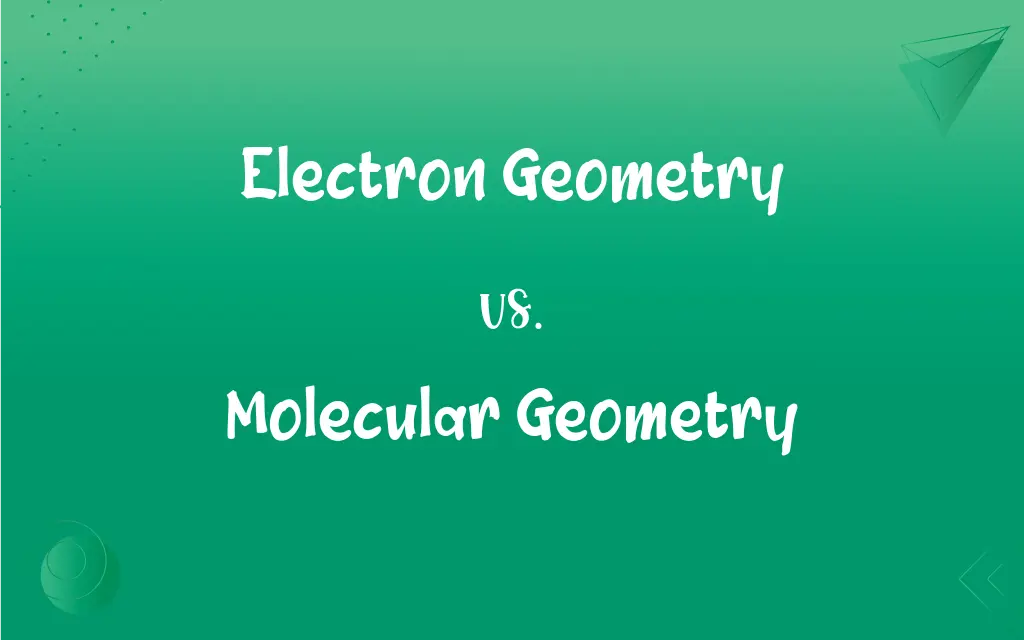Electron Geometry vs. Molecular Geometry: What's the Difference?
Edited by Janet White || By Harlon Moss || Updated on October 22, 2023
Electron geometry describes the arrangement of electron pairs, while molecular geometry describes the arrangement of atoms in a molecule.

Key Differences
Electron geometry considers the spatial arrangement of all electron pairs (bonding and non-bonding) around the central atom. This geometry is essential in predicting the shape a molecule may adopt. Molecular geometry, on the other hand, only focuses on the spatial arrangement of the actual atoms, disregarding lone electron pairs.
Both electron geometry and molecular geometry provide insight into the structural aspects of a molecule. However, electron geometry is more encompassing, taking into account both atoms and electron pairs. Molecular geometry, by focusing solely on atoms, gives a clearer representation of a molecule's physical shape.
When determining electron geometry, it's crucial to include both bonding electron pairs (those shared between atoms) and non-bonding electron pairs (lone pairs) around the central atom. For molecular geometry, these lone pairs are not considered. This distinction can lead to different geometric labels. For example, a molecule with four bonding pairs and no lone pairs has an electron and molecular geometry of tetrahedral. But if there are two lone pairs, the electron geometry remains tetrahedral, but the molecular geometry becomes bent.
Both electron geometry and molecular geometry play pivotal roles in the study of molecular shapes and polarity. Electron geometry can influence molecular geometry, and changes in the former can result in different shapes in the latter. However, when describing a molecule's shape, we refer to its molecular geometry.
Comparison Chart
Basis of Determination
Considers all electron pairs (bonding and non-bonding).
Considers only the positioning of atoms.
ADVERTISEMENT
Representation
Provides a comprehensive view of molecular structure.
Reflects the molecule's physical shape.
Influence
Determines molecular geometry based on electron arrangement.
Influenced by electron geometry.
Examples
Tetrahedral with four bonding pairs.
Bent with two bonding pairs and two lone pairs.
Importance in
Essential for understanding molecular shape and polarity.
Directly correlates to molecule's observable shape.
Electron Geometry and Molecular Geometry Definitions
Electron Geometry
A description of the positions of electron domains in a molecule.
Ammonia (NH₃) has a trigonal pyramidal electron geometry due to its three bonding pairs and one lone pair.
ADVERTISEMENT
Molecular Geometry
The observable shape of a molecule based on atomic positions.
Methane (CH₄) exhibits a tetrahedral molecular geometry.
Electron Geometry
A theoretical geometric structure determined by electron pair repulsion.
The electron geometry of BeCl₂ is linear because it has two bonding pairs and no lone pairs.
Molecular Geometry
The spatial arrangement of atoms in a molecule, excluding lone electron pairs.
Despite its tetrahedral electron geometry, water has a bent molecular geometry.
Electron Geometry
The spatial arrangement of all electron pairs around a central atom.
In water, the electron geometry around the oxygen atom is tetrahedral.
Molecular Geometry
The geometric shape indicating the corners where atoms are positioned in a molecule.
The molecular geometry of Carbon tetrachloride (CCl₄) is tetrahedral.
Electron Geometry
The geometric shape formed by electrons, including bonding and non-bonding pairs.
The electron geometry of methane (CH₄) is tetrahedral.
Molecular Geometry
The three-dimensional structure of atoms in a molecule as they are spatially arranged.
Ammonia (NH₃) has a trigonal pyramidal molecular geometry.
Electron Geometry
A tool in VSEPR theory to predict molecular shapes based on electron repulsion.
Carbon tetrachloride (CCl₄) has a tetrahedral electron geometry.
Molecular Geometry
A representation of how atoms connect and orient themselves in a compound.
BeCl₂ has a linear molecular geometry due to its straight arrangement of atoms.
FAQs
What's an example where electron geometry and molecular geometry differ?
In water (H₂O), the electron geometry is tetrahedral, but the molecular geometry is bent.
Why might electron geometry and molecular geometry differ for some molecules?
The presence of lone electron pairs can influence molecular geometry, making it different from electron geometry.
Which geometry plays a role in predicting the shape of a molecule?
Both electron geometry and molecular geometry play roles, but molecular geometry directly describes the shape.
What does electron geometry consider?
Electron geometry considers the arrangement of all electron pairs, both bonding and non-bonding, around a central atom.
Which geometry is crucial for understanding molecular polarity?
Both electron geometry and molecular geometry are important, but molecular geometry has a direct influence on polarity.
Which geometry reflects the actual observable shape of the molecule?
Molecular geometry reflects the molecule's physical, observable shape.
Why don't we always refer to electron geometry when discussing molecular shape?
Because molecular geometry, which excludes lone pairs, gives a clearer representation of a molecule's physical shape.
Which geometry is influenced by electron repulsion?
Electron geometry is influenced by the repulsion between electron domains, which in turn affects molecular geometry.
Can electron geometry and molecular geometry be the same for a molecule?
Yes, for molecules without lone pairs on the central atom, electron geometry and molecular geometry are the same.
How does VSEPR theory relate to electron geometry?
VSEPR theory uses electron geometry to predict the shape of molecules based on electron repulsion.
How can I determine the electron geometry of a molecule?
By considering all electron pairs (bonding and non-bonding) around the central atom and using VSEPR theory.
Can a molecule with a tetrahedral electron geometry have a bent molecular geometry?
Yes, if there are lone pairs on the central atom, such as in water.
Are both geometries important in chemistry?
Yes, both electron geometry and molecular geometry are fundamental concepts in understanding molecular structure and behavior.
What is the focus of molecular geometry?
Molecular geometry focuses on the spatial arrangement of atoms in a molecule.
Does molecular geometry consider lone pairs?
No, molecular geometry only considers the arrangement of atoms, not lone electron pairs.
Which geometry provides a comprehensive view of the molecule's structure?
Electron geometry provides a comprehensive view as it considers both atoms and electron pairs.
How does the electron geometry influence molecular geometry?
Electron geometry determines the arrangement of electron domains, which in turn affects the positioning and shape of atoms, defining molecular geometry.
Which geometry is more encompassing, electron or molecular?
Electron geometry is more encompassing as it considers all electron pairs.
Can electron geometry help in predicting molecular polarity?
Yes, along with molecular geometry, electron geometry provides insights into potential molecular polarity.
What role do lone pairs play in determining electron and molecular geometries?
Lone pairs influence electron geometry directly and can alter molecular geometry by pushing bonded atoms into different positions.
About Author
Written by
Harlon MossHarlon is a seasoned quality moderator and accomplished content writer for Difference Wiki. An alumnus of the prestigious University of California, he earned his degree in Computer Science. Leveraging his academic background, Harlon brings a meticulous and informed perspective to his work, ensuring content accuracy and excellence.
Edited by
Janet WhiteJanet White has been an esteemed writer and blogger for Difference Wiki. Holding a Master's degree in Science and Medical Journalism from the prestigious Boston University, she has consistently demonstrated her expertise and passion for her field. When she's not immersed in her work, Janet relishes her time exercising, delving into a good book, and cherishing moments with friends and family.































































